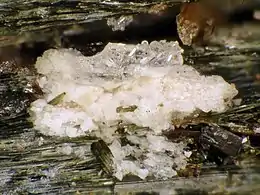Andrianovite
Andrianovite is a very rare mineral of the eudialyte group,[2] with formula Na12(K,Sr,Ce)6Ca6(Mn,Fe)3Zr3NbSi(Si3O9)2(Si9O27)2O(O,H2O,OH)5.[3][2] The original formula was extended to show the presence of cyclic silicate groups and silicon at the M4 site, according to the nomenclature of eudialyte group.[4] Andrianovite is unique among the eudialyte group in being potassium-rich (other eudialyte-group species with essential K are davinciite and rastsvetaevite[2]). It is regarded as potassium analogue of kentbrooksite,[3] but it also differs from it in being oxygen-dominant rather than fluorine-dominant.[2] Also, the coordination number of Na in this representative is enlarged from 7 to 9. The name of the mineral honors Russian mathematician and crystallographer Valerii Ivanovich Andrianov.[3]
| Andrianovite | |
|---|---|
 Andrianovite found in Russia | |
| General | |
| Category | Silicate mineral, Cyclosilicate |
| Formula (repeating unit) | Na12(K,Sr,Ce)3Ca6Mn3Zr3Nb(Si25O73)(O,H2O,OH)5 (original form) |
| IMA symbol | Adv[1] |
| Strunz classification | 9.CO.10 |
| Dana classification | 64.1.2.4 |
| Crystal system | Trigonal |
| Crystal class | Ditrigonal pyramidal (3m) H-M symbol: (3m) |
| Space group | R3m |
| Unit cell | a = 14.28, c = 30.24 [Å] (approximated); Z = 3 |
| Identification | |
| Color | Light yellow |
| Crystal habit | intergrowths (rims) with eudialyte |
| Cleavage | (001), imperfect |
| Fracture | Step-like |
| Tenacity | Brittle |
| Mohs scale hardness | 5 |
| Luster | Vitreous |
| Streak | White |
| Diaphaneity | Transparent |
| Density | 2.93 (measured), 3.02 (calculated) |
| Optical properties | Uniaxial (-) |
| Refractive index | nω=1.62, nε=1.62 (approximated) |
| Pleochroism | None |
| Ultraviolet fluorescence | No |
| Common impurities | Sr, Ce, Fe |
| References | [2][3] |
Occurrence and association
Andrianovite was discovered in pegmatites of Koashva open pit, Khibiny massif, Kola Peninsula. Russia. It coexists with aegirine, lamprophyllite, lomonosovite, microcline, mosandrite, natrolite, sodalite (silicates) and villiaumite.[3]
Notes on chemistry
The formula of andrianovite is devoid of some substituting elements and group, the most important being carbonate and chlorine. Minor substituting elements are lanthanum, neodymium, yttrium, titanium, barium, hafnium and aluminium.[3]
References
- Warr, L.N. (2021). "IMA–CNMNC approved mineral symbols". Mineralogical Magazine. 85 (3): 291–320. Bibcode:2021MinM...85..291W. doi:10.1180/mgm.2021.43. S2CID 235729616.
- "Andrianovite: Andrianovite mineral information and data". Mindat.org. Retrieved 2016-03-08.
- Khomyakov, A.P., Nechelyustov, G.N., Rastsvetaeva, R.K., and Rozenberg, R.A., 2009. Andrianovite, Na12(K,Sr,Ce)3Ca6Mn3Zr3Nb(Si25O73)(O,H2O,OH)5, a new potassium-rich mineral species of the eudialyte group from the Khibiny alkaline Pluton, Kola Peninsula, Russia. Geology of Ore deposits 50(8), 705-712
- Johnsen, O., Ferraris, G., Gault, R.A., Grice, D.G., Kampf, A.R., and Pekov, I.V., 2003. The nomenclature of eudialyte-group minerals. The Canadian Mineralogist 41, 785-794